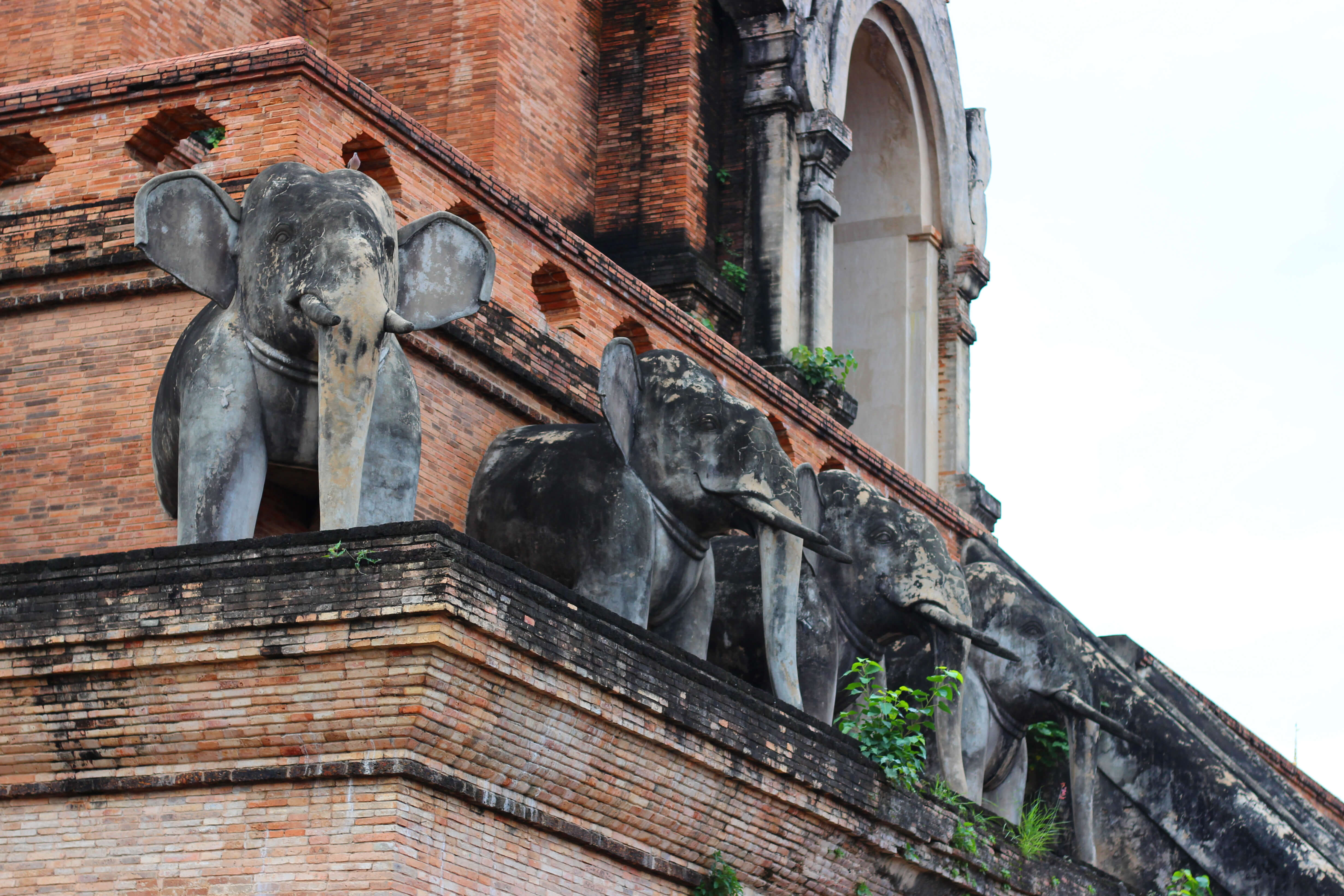
The ancient chedi at Wat Chedi Luang temple, Chiang Mai. Image by James Houston
Chiang Mai is fast becoming Asia’s most appealing tourist destination with its verdant scenery, glorious temples, thriving arts scene and seductively bohemian mood. Digital Editor Millie Walton ventures to Northern Thailand to discover the secrets behind the city’s allure.
Thailand’s never really appealed to me. I shunned the backpacking, full moon party scene for trekking in the Himalayas, safaris in Zimbabwe and little known rural villages where I could still feel traces of culture that elsewhere have been mowed over by skyscrapers and shopping malls. Yet, on a recent trip I found myself making a detour to meet a friend who’s recently moved to Bangkok, a city which she cheerfully describes as “the ugliest place in the world,” but for a day or two it’s fascinating to be wide-eyed in an Asian supercity.
By contrast, Chiang Mai is the kind of place you could stay for weeks, months or like many artists from around the world, years. We arrive on Sunday morning in early June, when monsoon season is at its teething stage. The showers are short, but extremely powerful and in response, the surrounding landscape shines vibrantly green. The city, for many, is Thailand’s adventure capital; within a few kilometres radius, there’s trekking, zip lining, white water rafting and multi-layered waterfalls cascading through the jungle, but it’s also slowly establishing itself as an artistic hub with live music venues, art galleries, yoga, studios artisan coffee shops and a collection of swanky boutique hotels.
Follow LUX on Instagram: the.official.lux.magazine

A suite at 137 Pillars
We check in to 137 Pillars, one of the most architecturally interesting five-star establishments in town, built around a grand restored Lana style Thai house. It’s a small hotel, just a few metres back from the Mae Ping River and a short walk from the city’s walled old town, but the spacious layout of suites in a collection of traditional style houses, clustered around the main wooden house and gardens, makes it seem almost like a mini village. As the first downpour of the day hits, we sit on our terrace watching the huge raindrops run down the palm leaves and soak into the earth. It’s over in less than ten minutes and we make our escape to the old town.

137 Pillars, Chiang Mai’s most stylish boutique hotel
Technically, the old town is the tourist hub of the city, but its also where most of the art galleries reside and the most beautiful temples. Compact in size with picturesque hidden alleyways, it’s perfect for exploring on foot. We begin at the Chiang Mai House of Photography, a sky blue wooden building hidden alongside the more dominating presence of the Lanna Folklife Museum. Downstairs is the room for lounging on sofas and armchairs with a photography book selected from one of the glass cabinets, whilst upstairs is the gallery space. As elsewhere in Thailand, the imagery here is currently dedicated to the recently deceased King. It’s an interesting and intimate exhibition examining a nation’s collective mourning, featuring four walls dedicated to the work of young photographers.
Read next: Guy Bourdin’s seductive world at Maison Chloé

Artist, Chumpol Taksapornchai
Whilst Chiang Mai isn’t home to any big-name galleries, as you dip in and out of the artist studios and cosy, colourful art spaces that line the streets, there’s an exciting sense of discovery and experimentation. Last year, the Chiang Mai Art Conversation (CAC), a four-year-old collective that aims to consolidate information about the city’s art spaces into a central database, issued its first Chiang Mai Art Map paving a route for visitors to explore the best of the local arts scene. One of the favourites is Matoom, run by artist Chumpol Taksapornchai. Filled with his large scale, dreamy water colours of imaginary landscapes and his mother’s colourful mobiles, it’s like wandering into a creative cave. “A lot of artists live here because we’re surrounded by nature and old culture. It’s an inspiring place to be!” Chumpol says of the city, “You have the smell of the countryside whilst being in a modern city at the same time.”

Wat Chedi Luang temple. Image by James Houston
At 6pm we make our way to Wat Chedi Luang temple, in time to watch the monks gathering inside for evening meditation. We sit for a while at the back listening to the chanting before circling the courtyard to admire the towering Lanna-style chedi built in 1441. When we leave, we find the streets lined with stalls for the Sunday night walking market. Here you can find local crafts, cheap souvenirs and sample the street food and whilst it can get crowded, it still manages to feel relaxed and soft. The people are gentle and smiling, eager for you to see their products, but never aggressive or pushy.
The market sprawls in a kind of maze and we’re lost for a while before we find our way back to the hotel for a late, but very welcome treatment at the spa. I opt for the 90 minute signature, combining Swedish massage techniques, with hot herbal compresses and Thai stretching. It’s a deeply relaxing and indulgent experience that seems fitting with Chiang Mai’s sensual aura, followed by an even later dinner and cocktails in the sultry, open air Dining Room restaurant that, on a balmy evening, feels almost Mediterranean.
Chiang Mai is one of the few destinations in Thailand, which manages to cater to the modern lifestyle without compromising ancient culture and traditions. Sadly, it probably won’t be long until that changes, but for now the city remains one of Asia’s most intriguing.








